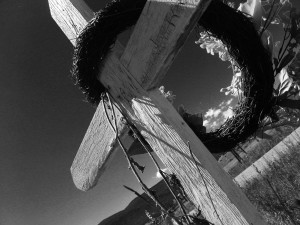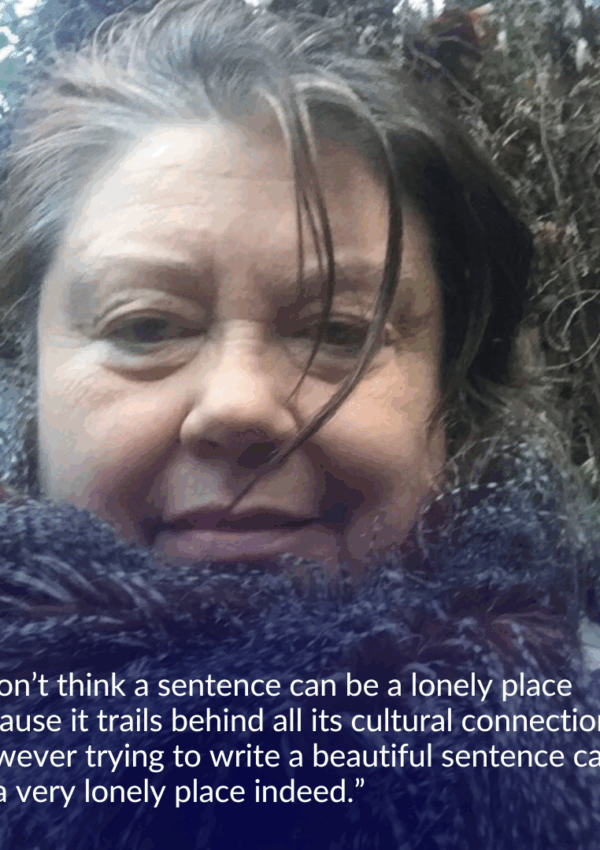(Dedicated to Idiots, Assholes, Delvers, and Thinkers)
Topographies are important. The feel of the land. A lover’s feel, inspirited and hearthsick; caressing hands roughly over protrusions and pressing fingers into the furrows of the terra—that’s how you write, that’s the magic, the only good way about it. You grab the land, you bear into it leaving an atlas of scars, you smell the copper in the wounds and the ozone in the rain. Does that makes sense, the minerals and the sky?
I grew up in a town with Descansos. It was a bucolic little valley in the high mountains, about seven thousand feet up in the rarefied air. It was a place of expanse and therefore freedom. In the whole highland region of my upbringing, the Descansos seemed like detritus scatted and abandoned along the roadside; crosses bursting up lively with plastic rose wreaths festooned loose in the high winds. The county mowers politely cut the roadside edge-weeds, berthing the chain harrow in a neat eye around each Descanso, careful not to disturb the memories.
Descansos were the marks, the life moments when the primitive quill had too little or too much Indian Ink and drooped and became indecisive and then decisive in an absolute sense. A life story relegated to an awkward, crashing blob. The Descansos were the places where individuals died along the bitumen. Ancillary families and people left all sorts of death paraphernalia scattered about the markers. Little madonnas, rosaries, miniatures of liquor, beers, bouquets, hats with sports logos, virgin joints, bras and panties with the smell attached, mardi gras beads, things like that. Passing by on the road, the odds and ends looked like a homeless toy collection.
 The Descansos themselves were the crosses stabbed into the earth, everything else was just the sprawl of our feelings. They had a certain reverence, but they were everywhere. Common reverences and common tragedies for us—on one stretch of road there are five Descansos in a single mile.
The Descansos themselves were the crosses stabbed into the earth, everything else was just the sprawl of our feelings. They had a certain reverence, but they were everywhere. Common reverences and common tragedies for us—on one stretch of road there are five Descansos in a single mile.
Most of the accidents were alcohol related, foolish bents derived from biology and an obsessive, neophyte experience. Here, maybe one in ten auto fatalities had nothing to do with the bottle. But it’s New Mexico, northeastern New Mexico, you have to understand. It’s Mora. We used to have the second highest D.U.I. fatality rate in the nation, per capita. We learned to drink and drive atavistically at a young age.
The Descansos served as a secondary grave, really—an account of the fallacy of constructs: flesh and steel and fiber-plastics. I can’t ever remember visiting a friend’s official epitaph, the rude stone in the graveplace. To the foolish, maybe the Descansos were the primary grave. Descansos, translated roughly, means a “rest” or an “interlude from toil.”
On the anniversary of the auto deaths, we’d congregate at the side of the road pouring beer and liquor shots over the crosses, toasting old friends, crying in the moted headlamps, starting bonfires at the edge of the asphalt as the crickets and sometimes coyotes serenaded the outskirts of light where both boys and girls relieved themselves in the tall grasses when it was time.
It was rather beautiful, if you can understand that. It’s like graffiti. It wasn’t ruined by some far-reaching moral philosophy imposed on us by wiser adults. It was hypocritical, maybe, that we memorialized death with the tools of death, but we felt all of us like soldiers. It wasn’t a didactic act, it was pure.
The cops let us alone. They knew. A boy died while driving his new motorcycle and they didn’t find him for a day and a half, misplaced briefly to the coniferous needles and shrub oak, the leggy grasses with bristling awns, as the bacterial gasses and distension frantically settled in. There was far too much topography to patrol. Why search us kids down? We weren’t a road hazard, our gatherings. Our land was rural and spread out, bucolic sallow prairieland and skylines of clean blue superimposed upon by explosive cauliflower clouds of monolithic proportions. And all of this, crashing upon the bleeding green and crushed-black Rocky Mountain peaks that made up our meridians.
Can you understand that this is a real place? Probably not. You can’t feel the land because it doesn’t exist for you.
These Descansos are everywhere.
Except one place.
There’s a road, a right fine road, that digs into a mountain face and snakes its way towards El Porvenir and Gallinas Canyon and Hermit’s Peak. Patrick Swayze used to live up there. Everyone in town loved him. He used to go to the Plaza Hotel, a sagging old relic of the railroad era. Patrick Swayze told the Plaza Hotel bartender once, I heard him say it, that when he came into the restaurant with his family, particularly his wife, and ordered an O’Doul’s, the bartender was to pour him a real beer disguised easily as a non-alcoholic draft. Patrick liked to drink but was officially rehabbed. Patrick died of pancreatic cancer. He used to live on that road, had a ranch. Patrick was a real person, not a myth or the air above a celebrated soapbox. Like all of us he had a tendency and a duration, and he wasn’t 50 feet tall. Patrick was a short guy.
The road up to Hermit’s Peak cuts into the mountain with no center line and barely enough room to pass a vehicle coming in the opposite direction down the mountain. It’s full of blind, tight-vicious turns and the road is old and riddled with crumbling potholes, the paving on the brim loosely mingling with the dry adobe earth.
If you are a native, you know about potholes. The best policy is to keep the holes underneath the body of the vehicle, put your tires on either side of them. Weave back and forth as you encounter the impurities. There are some guard rails, but there are also long spaces with no protection, just a steep drop of a hundred feet.
It’s a fun road to drive and no one ever seemed to traverse it with any sort of patience. There are a small few Descansos on this route, which is strange, as I myself have driven it drunk many times when I was in my teens. Reyes and Tone and Ronnie and I used to barrel down that mountainside, scudding with laughter, pulling on bottles and cans, chucking cigarettes out to the blacktop without care for wildfires.
You could almost feel a centripetal force as you went from one brief straightaway and into a curve and back to a straightaway and back into the curve. We tried to keep our speed up around the turns, slamming the gas as soon as we could see the end of the hug coming on. Sheer, selfish laughter, feeling our innards pull, twist, and contract pleasantly with the grade of the road, the displacement of gravity, the perfect easement of the steering circle.
Reyes is a CDL truck driver now. A good one. He was in trouble briefly for bad checks. Reyes’ dad finally took care of that before it got prison-serious.
Ronnie has his own Descanso now. It’s out there on the plains by I-25 where the lightning and clouds really have scope. It’s a flat strip with a wide sightline. Ronnie was trying to finish high school when his mom went back to smoking crack. Ronnie had to stay with a classmate and the classmate’s altruistic parents as Ronnie’s own mother went homeless. The two friends—or roommates, really—rolled their car and Ronnie was ejected and the car flipped right over him and broke him down the spine. The other kid was fine. They were just about to graduate. We used to say, about anything really, “Let’s do it. Let’s do it for Ronnie.” Then that fades and you aren’t sure why.
Tone and I grew up and moved away.
But I tell you that when I make trips back to the Mora mountain valley, muscles I didn’t realize were cranked suddenly relax. Watching all the disenthrallment, and life and biology around you, your bowels kinda drop. You feel like you have to take a shit that’s been inside you for an aeon.
It breaths deeply, the land. Mora is free like that. And freedom isn’t safe, it isn’t fair. Freedom is nature, and it has teeth and daggers lined just underneath the thin smatterings of dirt. It’s the tectonic processes of subduction and fat gathering and bulging out—you can expire from being too careful and heavy just as well as being rudderless and too radical.
Writing is like that. Art isn’t safe. Any writing worth a damn is aware of human and topographical dynamics that can’t be gentrified honestly. All you can do is familiarize yourself with the acreage, the places you excel, no matter how unfamiliar and uncharted, no matter how foolish the trek. You have to listen to the land, not interpretations of the land. Be careless with your stories. Burn your rudder. The ironies and paradoxes that exist are there if you laugh at the speed and the death and uncertainty all around you, and keep your fingers crossed and hope that you never grow up and grow out of it and never die. That’s how you write, the only good way about it really.
 nv baker writes short stories, essays, poetry, and is a graduate of UC Denver in the summa cum laude tradition. His scribbles are inspired by the resulting confusion of existing as a stymie tethered between the imagined and the rendered. nv baker was recently selected as The Missing Slate’s Author of the Month. His latest work appears in Weber: The Contemporary West, The Crab Creek Review, Main Street Rag, The Roanoke Review, The Missing Slate, and others. nbakerv@gmail.com twitter.com/nv_baker https://www.facebook.com/nathan.v.baker
nv baker writes short stories, essays, poetry, and is a graduate of UC Denver in the summa cum laude tradition. His scribbles are inspired by the resulting confusion of existing as a stymie tethered between the imagined and the rendered. nv baker was recently selected as The Missing Slate’s Author of the Month. His latest work appears in Weber: The Contemporary West, The Crab Creek Review, Main Street Rag, The Roanoke Review, The Missing Slate, and others. nbakerv@gmail.com twitter.com/nv_baker https://www.facebook.com/nathan.v.baker
You can read baker’s poetry in Black Fox Issue 14.



